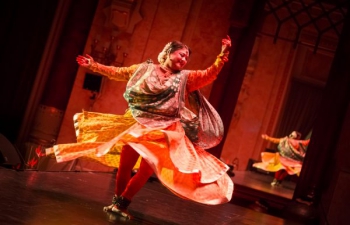Kathak Week – Workshop of Kathak Dance by Nrityashri Alaknanda
Back | Print
Kathak Week – Workshop of Kathak Dance by Nrityashri Alaknanda
Ms Nrityashri Alaknanda is organizing a 5 days extensive workshop for beginners & advanced level participants in the North Indian Classical Dance – Kathak in Amrita Sher-Gil Cultural Centre. Nrityashri Alaknanda is a Kathak exponent, choreographer, art motivator & Director of Alaknanda Institute for Performing Arts, Noida.
http://www.alaknandakathak.com/
Start : May 29th | End : June 3rd
Beginners Batch : 5:30 pm to 6:30 pm
Advanced Batch : 6:30 – 7:30 pm
Both the batches will be taught one or two compositions in pure Kathak style. At the end of the workshop, the participants will be handed over certificates of completion.
Workshop Fee : HUF 6500 for the five occasions. To be paid before the first class in cash to the organizer.
Registration: cultur@indianembassy.hu
About Nrityashri Alaknanda:
Since 1994, Nrityashri Alaknanda Dasgupta Bose has been an empanelled artist of the Indian Council of Cultural Relations, India. Her contributions in the field of art go beyond borders, creating a bridge between various art forms across the worlds. One of the most important aspects of her career has been imparting training of Kathak, to individuals in other countries and taking students from India keen to learn art forms of other countries. Since 2003, she has been travelling throughout Eastern & Western Europe & Asia giving performances & conducting workshops under a cultural missions with ICCR & other organisations. She realised that much work is needed to spread Kathak further in these countries, considering the love and interest visible in the people towards this art and India in general.
About Kathak:
Kathak is a Classical dance from the Northern part of India. The dance originated from Hindu temples in the form of storytelling and travelled to the courts of Hindu and then Muslim Kings.
’Katthak’ is a sanskrit word. ’Kathak ’ in sanskrit means ’storyteller, narrator’. Katthak word meaning was ’someone from singer-music player and dance jati’.
In early times, people who told stories combining singing, narrating and dancing were called ’Kathika’. For some reason over the years those who used to practice these art forms together, began to pursue singing, narrating dancing separately. Storytellers who told stories through dance continued to call them self ’Kathika’ or ’Kathaka’.
Kathak nritya evolved, it was called ’Kathak a’ or ’Katthaka’. Initially Kathak was performed in temples and stories were based on the life of Hindu Gods and Godesses. That time there was more emphasis on ’bhava’. Slowly, as the dance shifted from temples to the Mughal courts, the dance and dancers’ appearance-costume, jewelry etc changed. Footwork became more important than bhava or expressions. Tihai, tukdas, paran and other compositions emerged. Tabla became an important accompanying instrument. Dancers began to wear angrakhaa (Type of frocks), kurta etc. When nritya was performed on stage, both footwork and abhinaya / expressions became an important element of Kathak dance. First Kathak was performed only by one person, now artists perform together. The dance we know as Kathak nritya, is very different from the Kathak nritya of villages. This was also called the ’Natvari Nritya’ since it’s based on the life of Natvari, another name of Lord Krishna. There are many elements in Kathak dance of Lord Krishna’s legends, his character, childhood naughtiness, adulthood flirting & the ultimate – Raasa Nritya which he danced with the gopikas (village belles) & Radha.

















